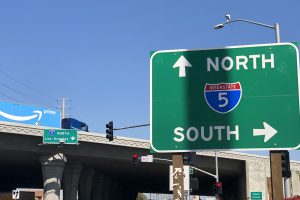Corridor runs from Mexico to Canada.
Just as Tesla said it was accelerating the timeframe for production of its battery-electric semi and rival Nikola showed off its BEV model, the way these things are going to get charged up on the West Coast has just become a little clearer.
Nine electric utilities and two agencies representing more than two dozen municipal utilities in California, Oregon and Seattle have come up with a plan to add electric vehicle charging for freight haulers and delivery trucks at 50-mile intervals along Interstate 5 and adjoining highways.
This more than 1,300-mile stretch of interstate from Mexico to Canada has been dubbed the West Coast Clean Transit Corridor, and all of the stake holders rolled out a new study showing just what they want to do to make it happen.
The study proposes a phased approach for electrifying the I-5 corridor, starting with the installation of 27 charging sites along I-5 at 50-mile intervals for medium-duty electric vehicles, such as delivery vans, by 2025. Then, later, 14 of the 27 charging sites would be expanded to also accommodate charging for electric big rigs by 2030, when it is estimated that 8% of all trucks on the road in California could be electric.
Several utilities have pulled together to posit the idea of a charging corridor on I-5.
“The results of this study provide a roadmap for electric utilities in Washington, Oregon and California to help electrify transportation in a coordinated fashion,” said Katie Sloan, director of eMobility and Building Electrification for Southern California Edison, one of the study’s sponsors.
Of the 27 proposed sites, 16 are in California, five are in Oregon and six are in Washington. An additional 41 sites on other highways that connect to I-5 are being proposed for electrification. Those highways include Interstates 8, 10, 80, 210 and 710 and state routes 60 and 99 in California; I-84 in Oregon and I- 90 in Washington.
This means the millions of dollars invested by companies like Amazon, UPS, FedEx and others to develop battery-electric delivery vehicles will see a real return. As for the larger Class 8-style electric rigs from Tesla, Nikola, Thor and others, the future is a bit further down the road.
However, many of those vehicles were initially seen only as vehicles to help improve air quality while moving freight from ports to intermodal distribution centers within a 200-mile range where they could offload their cargo and it would be transferred to more conventional transportation options.
The map of the West Coast Clean Transit Corridor.
Key findings in the report include that:
- Most utilities in California, Oregon and Washington have enough capacity in urban areas along I-5 to support interconnections with the medium-duty charging sites. Rural areas are more of a challenge and none of the rural areas currently have capacity to serve heavy-duty site development.
- Stakeholders, including utilities, must begin proactive engagement to accommodate long lead times (multiple years in most cases) for system planning and site development.
- Clean fuel policies in West Coast states continue to drive transportation electrification in the near term and additional state, federal and private programs that provide funding for electrification could further accelerate electric truck adoption.
- Utilities should serve as trusted infrastructure providers that can be leveraged to collaborate across a broad range of industry stakeholders, educate customers, help standardize systems of charging equipment for trucks and ensure safe deployment of charging sites.
- Fleet operators surveyed as part of the study identified that access to public charging would accelerate deployment of electric vehicles because their trucks could use public sites to support their operations.
“Electrifying delivery, freight and other commercial transportation on I-5 and adjoining highways will help bring us closer to achieving clean energy and environmental goals, and will mean major health benefits to the communities near those highways,” said Eva DeCesaro, senior product manager, Transportation Electrification for Pacific Power. “This is especially true for underserved communities that are disproportionality impacted by carbon pollution.”
Other sponsors of the study are Los Angeles Department of Water & Power, Northern California Power Agency, Pacific Gas and Electric Company, Pacific Power, Portland General Electric, Puget Sound Energy, Sacramento Municipal Utility District, San Diego Gas & Electric, Seattle City Light and Southern California Public Power Authority.


